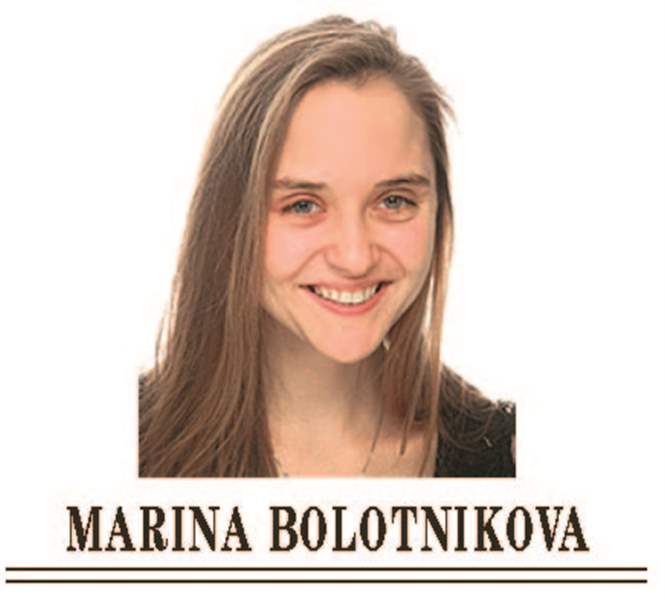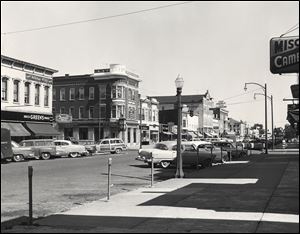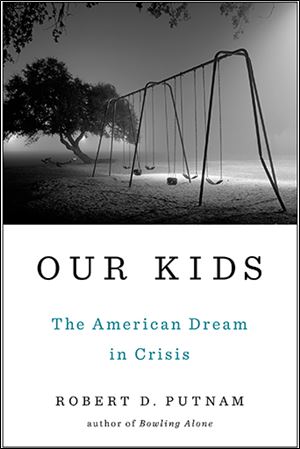
Port Clinton’s kids, then and now, speak to all of us
It’s our challenge to take responsibility for the fates of kids who live lives different from our own
3/22/2015

Sixty years ago, Robert Putnam earned spending money as a paperboy for The Blade in Port Clinton. Today, he is one of the best-regarded political scientists in the country.
His father, a native Toledoan who graduated from Libbey High School, moved his family to Port Clinton after serving in World War II and became a small businessman. When Professor Putnam attended the local high school in the 1950s, the manufacturing town was “a passable embodiment of the American Dream,” he writes in his new book, Our Kids: The American Dream in Crisis.
Mr. Putnam’s book tells the story of economic mobility in America over the past few generations, in part with numbers and in part with vivid portraits of young Americans and their parents.
Mr. Putnam begins in Port Clinton, where he benefitted from the town’s robust economy, communitarian spirit, and educational opportunity.
“Many of my classmates say exactly the same words: ‘We were poor, but we didn’t know it’,” Professor Putnam told me last week, “In terms of community support from our town, we were rich.”
He is careful to concede that gender and race posed major barriers to mobility for women and African-Americans before the civil rights era. Still, his concession reads more like a footnote than a serious challenge to the claim that the American dream was once open to everyone.
His success in high school, and a scholarship from a local employer, helped him earn degrees from Swarthmore College and Yale University. Today, he’s a celebrated professor at Harvard.

Port Clinton of the 1950s was a manufacturing town and ‘a passable embodiment of the American Dream,’ Robert Putnam writes.
In the 1950s and 1960s, income inequality in America was nearly as low as it’s ever been. Today, Mr. Putnam reports, it’s the highest it’s been since the Gilded Age, with devastating impacts on kids at the bottom of the economic ladder. “A half century later,” he writes, “life in Port Clinton, Ohio, is a split-screen American nightmare.”

Robert Putman’s new book, ‘Our Kids: The American Dream in Crisis,’ relates what’s happened to economic mobility in America over the past few generations.
Narrowed horizons
The book’s brevity and readability are testaments to Professor Putnam’s skill as a communicator, not to the simplicity of his argument. He doesn’t shy away from the thicket of variables — the economy, culture, community, the breakdown of the family — that work in tandem to create and compound inequality.
The difference between Port Clinton then and now isn’t just a matter of household income, but also of poor kids’ lack of access to trustworthy neighbors and mentors who could help them imagine a world beyond their horizons.
Mr. Putnam’s story is familiar: The collapse of American manufacturing in the 1980s sapped communities of their resources and gave rise to a vicious cycle of poverty, violence, economic segregation, and family dysfunction — not just in Rust Belt towns such as Port Clinton, but in cities all over America.
What distinguishes Our Kids from the pack of current books on inequality are its extraordinary stories of families across the country. Professor Putnam gracefully weaves data with stories of families that have attained tremendous success, and with rarely heard stories of families living in destitution.
Elijah, a young man who was abandoned by his parents, was so hardened by a life of poverty and violence in New Orleans that he described the pleasure he gained from getting into fights and hurting his victims. Mr. Putnam sketches such subjects with rare compassion, and takes care not to fault them for the circumstances they were born into.
If one theme unifies his insights in Our Kids, it’s that people are deeply social creatures, shaped by their social worlds in fundamental ways that aren’t fully understood. It’s our challenge to take responsibility for the fates of American kids who live lives different from our own — to see them as “our kids.”
Our Kids isn’t a story about the college-educated, downwardly mobile millennial who has done everything right, but can’t seem to cash in her share of the American dream, or so the trope goes.
“The use of the word ‘millennial’ tends to hide the fact that among millennials there are huge differences,” Mr. Putnam told me. “We know perfectly well that well-educated millennials are doing much, much better than their less-educated peers.”
In this regard, Professor Putnam offers a wiser and more farsighted forecast than much of what’s been asserted about millennials. Today’s educated twenty-somethings had the misfortune of graduating after the financial crisis.
But over broader time horizons, they’re likely to join America’s privileged classes. Higher education, not volatile metrics such as a worker’s first income, is Mr. Putnam’s preferred measure of class.
Particularly interesting, and likely vexing to staunch liberals, is Mr. Putnam’s treatment of how schools shape students — and how they don’t. Per-student funding, he argues, isn’t very predictive of student outcomes.
Far more important is the social composition of schools: Wealthy and poor kids alike do better in school when their classmates come from affluent, educated homes. Designing mixed-income neighborhoods and school districts would do far more to close the achievement gap than ramping up funding to poor schools, he argues.

Putnam
Cause and effect
Conspicuously missing from Mr. Putnam’s story are some of the political forces that are responsible for spiraling inequality. These include the waning power of unions and the rise of the financial services industry, which many economists believe has diverted wealth from labor to capital and encouraged firms to slash wages.
He stresses the need for sustained wage growth, but shies away from the policies required to get there: a higher minimum wage and stronger overtime pay rules, to name a few. Professor Putnam says his main project was showing the consequences of inequality for kids, not its causes.
“There have been a lot of polemical books about inequality, and all that literature is really important,” he said. “But I wanted to say, OK, given that, what are the implications for kids?”
Avoiding polemics appears to be an important goal for Mr. Putnam. He aims to appeal to Americans and lawmakers on both sides of the aisle, and he meets the challenge admirably.
He tells all of us why we should care about inequality — its effects on lost productivity and weakened democracy, a sense of Christian decency. He implores all of us to commit to reversing it, even if we can’t agree on every policy prescription.
His pragmatism befits a man who has little patience for fundamentalism, and who fits his political analysis to reality, not the other way around.
The worst thing we can do, Mr. Putnam suggests, is to ignore the rift between poor and prosperous Americans, to pretend that it’s not our responsibility or that the market will sort it out. That means everyone, from every political persuasion, must share in the solution.
In their own way, the objects reflected in the mirror Professor Putnam holds up to American life — the degradation of collective responsibility, the breakdown of social networks, the basic indignity of inequality — are larger than they appear.
Marina Bolotnikova is an editorial writer and columnist for The Blade.
Contact her at: mbolotnikova@theblade.com or at 419-724-6522 or on Twitter @mbolotnikova.